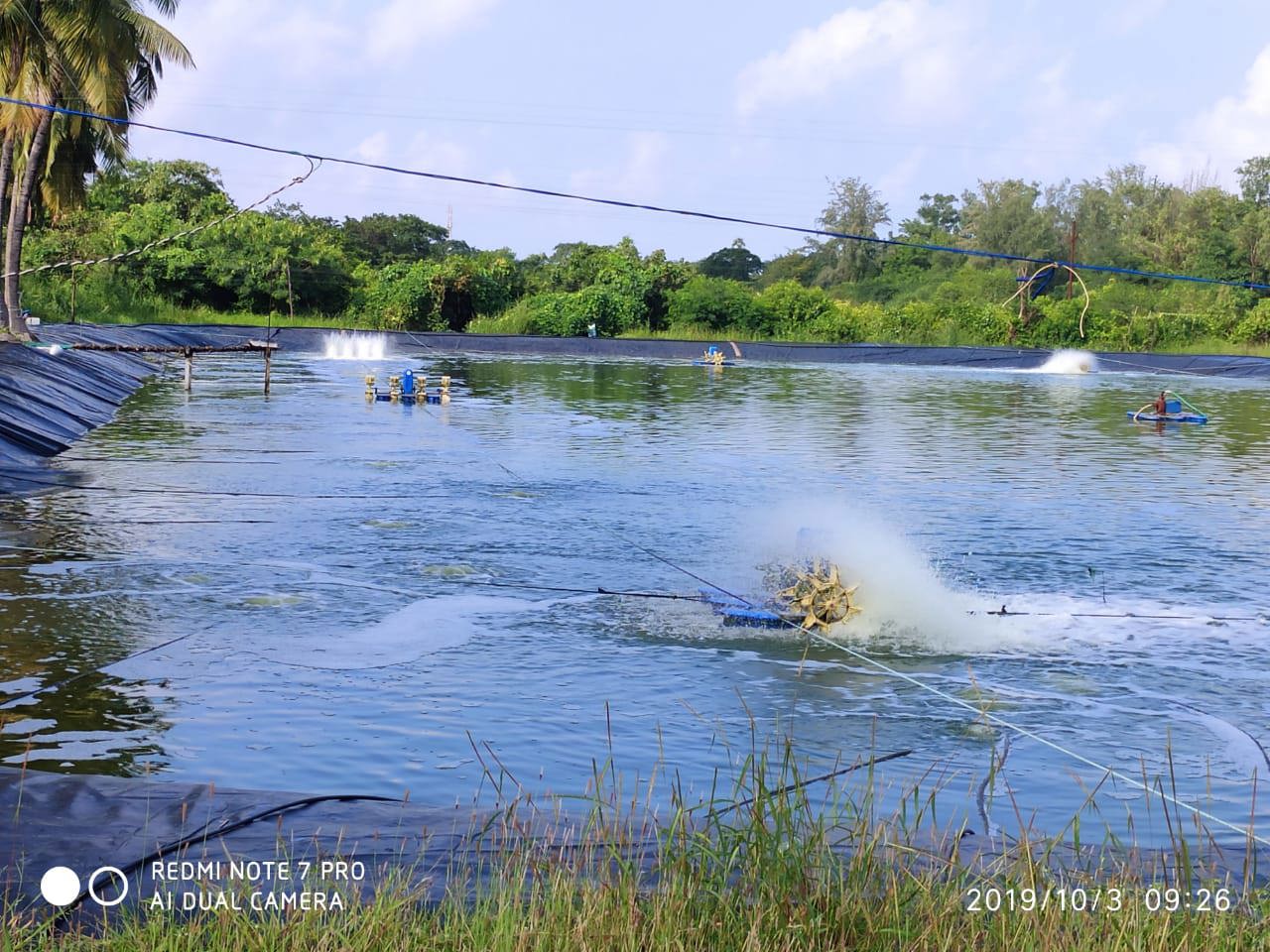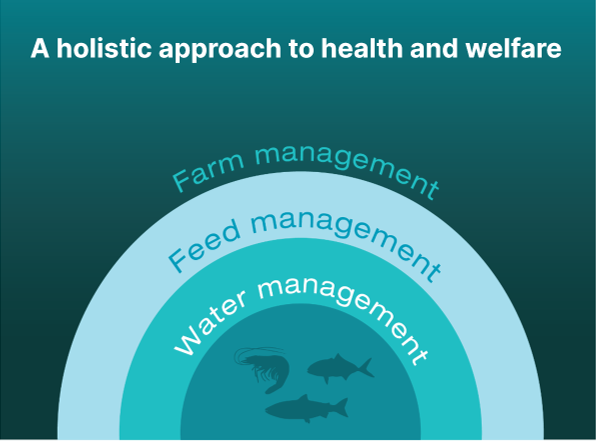Aquaculture is not just an important economic activity but also a sustainable option to provide protein rich food to the ever-growing global population. To meet the global demand, aquaculture production practices have been intensified to a greater extent both in technological and practical measures.
Water Management in shrimp and fish culture with probiotic and minerals
Water quality is the most important factor affecting shrimp and fish health and performance in aquaculture production systems.

Fish and shrimps are dependent on the water they live in for all their needs, including breathing, eating, reproducing and growing. Inadequate water quality causes more losses than any other problem and to a great extent water quality determines the success or failure of any farming operation.
The aquatic environment is composed of many aquatic variables. Farmers must know the variables that are potential sources of stress for the fish since these variables may also explain the causes of fish culture problems. Water quality parameters, which are of prime importance, are mainly temperature, salinity, turbidity, oxygen, CO2, nitrogen, ammonia, pH, alkalinity, hardness, minerals etc. Proper management consists also of monitoring the ponds regularly, keeping good records and planning ahead for the operation of your farm. Most likely, a pond with good water quality will produce more and healthier animals than a pond with poor quality.
Finally, the success any culture system is no longer a question of a single approach. The success will only by achieved when all the aspects regarding water management are tightly linked to a feed and farm management and strong biosecurity practices.

It is why Skretting is the ideal partner to our business. Our experienced technical and sales team can work directly with you and support you to manage your business effective, help you to manage appropriately all the aspects regarding water, feed, farm and biosecurity management processes and put in place measures and strategies development plan to guarantee the success of your business.
PROBIOTICS
Due to intensification in aquaculture practices, the emergence of a wide array of pathogens resulted in infectious diseases that are the major limiting factor in most aquaculture operations. The use of probiotics is one of the most important developments for sustainable aquaculture due to the fact they are safe, effective and eco-friendly alternative to antibiotics by stimulating animal growth and general health status.
The literal meaning of probiotic is pro=for and biotic= life i.e. for life. Verschuere and colleagues proposed an aquaculture-based definition of probiotics, which states ― A probiotic is defined as a live microbial adjunct which has a beneficial effect on the host by modifying the host associated or ambient microbial community, by ensuring improved use of the feed or enhancing its nutritional value, by enhancing the host response towards disease, or by improving the quality of its ambient environment.
The immense potential of probiotics lies on their multiple mechanisms in conferring not just benefits to the host, shrimp and fish, but also helping to eliminate organic wastes and pollutants from the water and bottom of the ponds. So, based on the mode of action, probiotics can be divided into two broad categories: (a) gut probiotics: which are administrated orally along with food to improve the gut associated beneficial microbial flora and, (b) water probiotics: these types of agents that will be administrated directly to the water and it will promote an improvement in water quality and bottom pond health status – Bioremediation.
The mechanisms of action of probiotics in aquaculture are not yet fully known. Their presumed modes of action are based on the number of studies done in various species. Firstly, the enhancement of feed utilisation and weight gain in aquatic animals. Probiotic microorganisms have beneficial effects on the GIT (gastrointestinal tract)/ gut of aquatic animals in the digestion of dietary nutrients as well as in production of energy. Diets supplemented with probiotics are digested and absorbed more efficiently due to the ability of probiotics to produce digestive enzymes (amylases, proteases, and lipases, etc.) and provide nutrients (vitamins, fatty acids and amino acids). These can contribute to the better assimilation of diet components resulting in improved general health condition and growth performance of aquatic animals. Additionally, a few recent studies have shown that probiotics may also stimulate the nutrient absorption by increasing the surface area of the host GIT, based on quantitative changes in histological measurements of the area of intestinal fold, enterochromaffin cells, and microvillus.
Secondly, they facilitate competition for binding sites. It is also known as "competitive exclusion", where the adherence of certain probiotics to the mucosal layer of the intestine results in the formation of a physical barrier, suggested to inhibit infection pathogens through the blocking of the common route used by the pathogenic bacteria.
Third, probiotic bacteria may release a variety of chemical substances that have a bactericidal or bacteriostatic effect against bacteria pathogens. These inhibitory substances belong to different origin such as proteinaceous substance (lysozyme and different kind of proteases), chemical (hydrogen peroxides), and iron-chelating compound like siderophores and bacteriocin. At the same time, probiotic bacteria, also can produce organic acids that lower the pH in the gastrointestinal tract. This prevents the growth of various pathogens but triggers the development of certain species of Lactobacillus, which are beneficial to the host.
Fourth, they compete with the pathogens for utilization of nutrients. Probionts compete with the harmful pathogens for nutrition absorption; thus, reducing the amount of nutrients for the latter. The lack of nutrients for the pathogenic bacteria is a limiting factor for their maintenance.
Lastly, probiotics play a beneficial role as immunostimulatory to assist in the protection of aquatic cultured species by reducing the impact of diseases and entrance of pathogens. They stimulate the various components of the immune system. Some probiotic bacteria are directly linked to the stimulation of the immune response, by increasing the production of antibodies, activation of macrophages, T-cell proliferation and production of interferon increasing the resistance of aquatic animals against stress caused by several environmental hazards during the aquaculture activity.
When applied directly in the water, probiotics will also play a crucial role as a primary tool in water quality and pond bottom quality management. Probiotic Bacteria will have a direct impact on ammonia and nitrates via assimilation and an indirect impact in the nitrites since by maintaining a low level of ammonia this will gives time to nitrites oxidize bacteria to develop. The probiotic bacteria can help as well to breakdown and consume the organic matter from the pond as well to exclude the pathogenic bacteria from the specific medium (Figure 1).
In order to be consider a good candidate and selected as probiotic bacteria for use in the aquaculture industry, bacteria must possess certain properties, such as (i) not be harmful to the host; (ii) be accepted by the host; (iii) reach the location where the effect is required to take place; (iv) work in vivo as opposed to in vitro findings; and (v) not contain virulence resistance genes; (vi) evaluation of the ability of potential probiotics to out-compete pathogenic strains; (vii) evaluation of pathogenicity and survival test; (viii) economic cost/benefit analysis.
Among all the species of probiotics discovered, Bacillus species, a Gram-positive endospore-forming bacteria, are the most widely used as aquaculture probiotics. Although several strains belonging to different Bacillus species such as Bacillus subtilis, Bacillus cereus, Bacillus licheniformis, Bacillus pumilus among others appears in the label of different commercial products, not all species and/or strains has the potential to be used as biological agents for water quality enhancement or gut enhancer.
The choice of the right probiotic should rely in some factors such as: i) number of viable colonies forming units (cfu); ii) quality standards of the manufacturer; iii) screening strains with good remediation characteristics still remains a fundamental step towards developing commercial microbial agents.
Quality matters for any health supplement, and that goes triple for probiotics. Many commercial brands lack the technology to identify specific strains and how much of that strain really each product contains. A research conducted in Thailand showed that although a lot of commercial probiotic products in the market claims to have a high concentration of bacteria in fact just a few (2 in 12) really meet the label specifications. Hence it is very important to choose the right probiotic for the shrimp/ fish culture.

AquaCare Control is a probiotic solution, its formulation is designed to improve water quality, support growth and feed conversion ratio for shrimp and fish. Its probiotic species, were selected for their ability to inhibit and suppress pathogenic vibrio species (by producing bacteriocins and enzymes that can disrupt vibrio communication reducing their virulence – Quorum Quenching) as well by their ability to assimilate the nitrogen compounds and secreting enzymes that will help to “cut in small pieces” the complex molecules that compose the sludge (organic matter) make then easy to be use by the heterotrophic bacteria and phytoplankton. Hence, an effective product to control sludge, ammonia and pathogens.